
Sometimes winter weather sucks. High winds, torrential downpours, freezing rain – that’s when I settle into a comfortable chair with a cup of hot chocolate and a favorite book. Don’t get me wrong, I love hiking in the elements! But sometimes we must concede to Mother Nature. She reigns supreme and we are her humble, biodegradable subjects.
Outside of a dog, a book is a man’s best friend.
Inside of a dog it’s too dark to read.
– Groucho Marx
When I can’t be outside, reading about the outdoors is the next best thing. Last year’s book list turned out to be very popular. So I thought I’d put together another for this year’s holiday season. These books make great gifts for your favorite outdoorsy person.
Not all of the books I recommend below were published this year. Some are “classics” that I have not had the chance to recommend before. But they are still relevant and will be warmly received by lovers of the outdoors.
I hope you are inspired by one of the titles below. There are many terrific books that did not make this year’s list. So if you have a recommendation, please leave me a comment below. I’m always looking for more good books to read!
Animals and Nature
Mother Nature is always speaking. She speaks in a language understood within the peaceful mind of the sincere observer.
– Radhanath Swami
The following four books help you observe and learn from the natural world.
1. Bird Sense, What It’s Like to Be a Bird (Tim Birkhead)
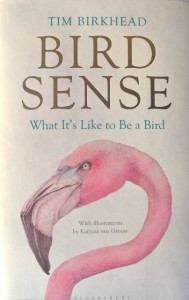 Have you ever dreamed of soaring high above the earth? This amazing book is as close as many of us will get. Through research and first-hand stories, Birkhead shows us how birds see, hear, touch, taste, and smell. He delves into their magnetic sense and even tackles the question of whether birds have emotions. In the process, we get insight into how natural science advances – through mistaken beliefs, hard work, and happy coincidence.
Have you ever dreamed of soaring high above the earth? This amazing book is as close as many of us will get. Through research and first-hand stories, Birkhead shows us how birds see, hear, touch, taste, and smell. He delves into their magnetic sense and even tackles the question of whether birds have emotions. In the process, we get insight into how natural science advances – through mistaken beliefs, hard work, and happy coincidence.
2. Tom Brown’s Field Guide to Nature Observation and Tracking (Tom Brown Jr., with Brandt Morgan)
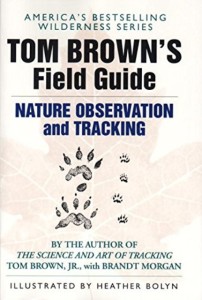 Tom Brown is a controversial figure in many circles because of his extraordinary claims. But whether or not you believe he can stroke a doe’s back without it noticing, you will appreciate the solid techniques Brown teaches. He explains skills and exercises that help you slow your mind and open your senses to the natural world. He covers ways to expand your awareness, move silently through the forest, and to use camouflage. The book’s first part is about nature observation. The second is dedicated to tracking and trailing. For me, the part on nature observation makes this book worthwhile.
Tom Brown is a controversial figure in many circles because of his extraordinary claims. But whether or not you believe he can stroke a doe’s back without it noticing, you will appreciate the solid techniques Brown teaches. He explains skills and exercises that help you slow your mind and open your senses to the natural world. He covers ways to expand your awareness, move silently through the forest, and to use camouflage. The book’s first part is about nature observation. The second is dedicated to tracking and trailing. For me, the part on nature observation makes this book worthwhile.
3. Mammal Tracks & Sign: A Guide to North American Species (Mark Elbroch)
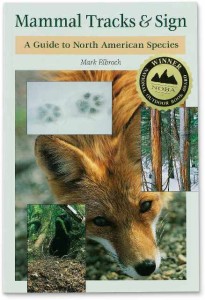 This is the classic field guide for animal tracking. I use Elbroch’s California book all the time. On several occasions I have consulted my friends’ copies of Mammal Tracks & Sign as we pieced together difficult tracking puzzles. This book always provides useful information. If you want to get serious about animal tracking, Elbroch is the go-to guy for information. I heartily recommend all his tracking books.
This is the classic field guide for animal tracking. I use Elbroch’s California book all the time. On several occasions I have consulted my friends’ copies of Mammal Tracks & Sign as we pieced together difficult tracking puzzles. This book always provides useful information. If you want to get serious about animal tracking, Elbroch is the go-to guy for information. I heartily recommend all his tracking books.
4. What The Robin Knows, How Birds Reveal the Secrets of the Natural World (Jon Young)
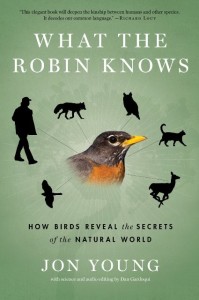 Birds see more than we do. And they tell all their friends what they see. If you can understand their chatter, you can divine what is happening in the forest. This is the best book on bird language I have seen. The text moves a little slowly, but it shows you how to interpret bird calls, bird behavior, and even the “shape” of their flight. It is a codebook that helps you peer farther into the secret life of the forest.
Birds see more than we do. And they tell all their friends what they see. If you can understand their chatter, you can divine what is happening in the forest. This is the best book on bird language I have seen. The text moves a little slowly, but it shows you how to interpret bird calls, bird behavior, and even the “shape” of their flight. It is a codebook that helps you peer farther into the secret life of the forest.
Bushcraft and Survival (General)
The next four books are about wilderness survival. Three are useful manuals that educate and entertain. The third is the incredible true-life story of a young mariner’s desperate struggle for survival on the high seas.
5. 98.6 Degrees: The Art of Keeping Your Ass Alive (Cody Lundin)
 Cody Lundin wrote this book long before he became a reality television star. Its premise is that wilderness survival is about keeping your core body temperature at a healthy 98.6 degrees Fahrenheit. A lot of the drawings are irreverent, and even crass. But the advice is sound. Certain of his equipment recommendations are dated, but this book is useful because he gives high quality no-nonsense advice about risk assessment, priorities, dealing with fear, and cultivating a survivor’s attitude.
Cody Lundin wrote this book long before he became a reality television star. Its premise is that wilderness survival is about keeping your core body temperature at a healthy 98.6 degrees Fahrenheit. A lot of the drawings are irreverent, and even crass. But the advice is sound. Certain of his equipment recommendations are dated, but this book is useful because he gives high quality no-nonsense advice about risk assessment, priorities, dealing with fear, and cultivating a survivor’s attitude.
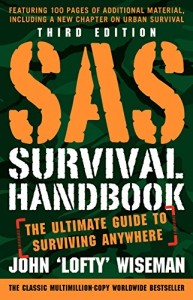 This classic survival manual is written as a handbook. It does not have narrative prose or detailed instructions. But it illustrates a variety of modern wilderness survival techniques adapted for different regions of our planet. It is a starting point for deeper learning and a great introduction for the beginner. My 2004 edition is well-thumbed.
This classic survival manual is written as a handbook. It does not have narrative prose or detailed instructions. But it illustrates a variety of modern wilderness survival techniques adapted for different regions of our planet. It is a starting point for deeper learning and a great introduction for the beginner. My 2004 edition is well-thumbed.
7. Where there is no Doctor (David Werner, Carol Thuman, Jane Maxwell)
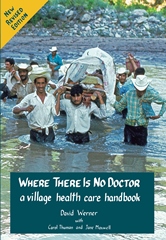 This handbook is written for people who are working in third-world countries where medical care is not always available. It covers sickness, caring for people without medicine, how to measure and give modern drugs, disease prevention, and much more. Each chapter goes into specific detail and is extremely thorough. The book is designed to be a practical guide to healing when there is no doctor.
This handbook is written for people who are working in third-world countries where medical care is not always available. It covers sickness, caring for people without medicine, how to measure and give modern drugs, disease prevention, and much more. Each chapter goes into specific detail and is extremely thorough. The book is designed to be a practical guide to healing when there is no doctor.
For a health worker living in a third-world country, this is an invaluable book. But it will also appeal to anyone living in the United States who may be far from professional care.
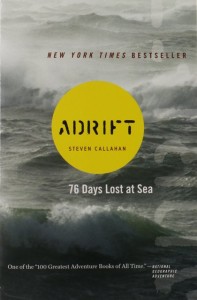 I first learned of this book through a dramatization in Ray Mears’ Extreme Survival video series. It tells the astounding story of Steven Callahan. When his boat capsized, Callahan drifted for 76 days, more than 1,800 miles before being rescued. National Geographic Explorer called this book, “One of the 100 best adventure books of all time.” Even knowing the outcome, you get caught up in the suspense.
I first learned of this book through a dramatization in Ray Mears’ Extreme Survival video series. It tells the astounding story of Steven Callahan. When his boat capsized, Callahan drifted for 76 days, more than 1,800 miles before being rescued. National Geographic Explorer called this book, “One of the 100 best adventure books of all time.” Even knowing the outcome, you get caught up in the suspense.
Bushcraft Skills
Here are two books that teach “hard skills.” Both cover topics where it is hard to find a good books on the subjects.
9. Swedish Carving Techniques (Wille Sundqvist)
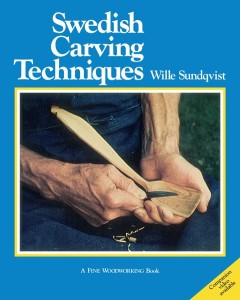 Many of us don’t have an older relative to teach us how to use a knife. We are left on our own to flounder. The forehand grip and the chest-leaver grip are easy to learn on your own. But what about techniques where the knife is moving toward your body? This book shows how to safely use woodworking tools including the knife and axe. It covers selection, storage, and maintenance as well as proper use. The book provides simple projects such as coat hooks and buttons for you to practice your skills. Pictures help you master the techniques required for each project. This book was translated into English from the original Swedish.
Many of us don’t have an older relative to teach us how to use a knife. We are left on our own to flounder. The forehand grip and the chest-leaver grip are easy to learn on your own. But what about techniques where the knife is moving toward your body? This book shows how to safely use woodworking tools including the knife and axe. It covers selection, storage, and maintenance as well as proper use. The book provides simple projects such as coat hooks and buttons for you to practice your skills. Pictures help you master the techniques required for each project. This book was translated into English from the original Swedish.
10. The Universal Toolkit (Paul Douglas Campbell)
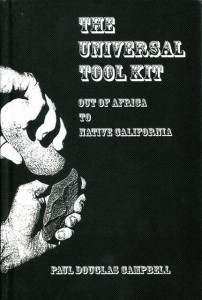 I admit it. I don’t like flintknapping. The materials and techniques just aren’t for me. But this book shows you how to “bash stones together” in a wonderfully practical way I admire. It covers both the manufacture and the use of stone tools. The book also has a terrific section dedicated to Atlatls.
I admit it. I don’t like flintknapping. The materials and techniques just aren’t for me. But this book shows you how to “bash stones together” in a wonderfully practical way I admire. It covers both the manufacture and the use of stone tools. The book also has a terrific section dedicated to Atlatls.
This is a textbook, so it can be a little dry at times. But it is rich in drawings and pictures that go a long way toward improving your understanding of how stone tools are made and used. For anyone interested in improvising stone tools in the wilderness, this book… wait for it… rocks!
Other Gift Guides on NatureOutside
2018
10 Books for Bushcrafters, Nature Lovers, and People Who Love the Outdoors (2018)
2017
10 Books for Bushcrafters, Nature Lovers, and People Who Love the Outdoors (2017)
2016
10 Equipment Gifts for Bushcrafters, Nature Lovers, and People Who Love the Outdoors (2016)
10 Books for Bushcrafters, Nature Lovers, and People Who Love the Outdoors (2016)
2015
10 Equipment Gifts for People Who Love the Outdoors (2015)
10 Books for People Who Love the Outdoors (2015)
2014
10 Equipment Gifts for Bushcrafters, Nature Lovers, and People Who Love the Outdoors (2014)
10 Books for Bushcrafters, Nature Lovers, and People Who Love the Outdoors (2014)
Top 10 Videos for Bushcrafters, Nature Lovers, and People Who Love the Outdoors (2014)
For fun facts and useful tips, join the free Bushcraft Newsletter.



Hmm, I’ve only read two of those books (so far) but when I first found Elbroch’s mammal tracking book, wow, was I thrilled. Still am. I gotta check you list from last year.
Cindy, I agree that Elbroch’s books are terrific. I have been meaning to go back and reread his writings on how to identify animal scats. I haven’t quite got my small mammal “stuff” together.